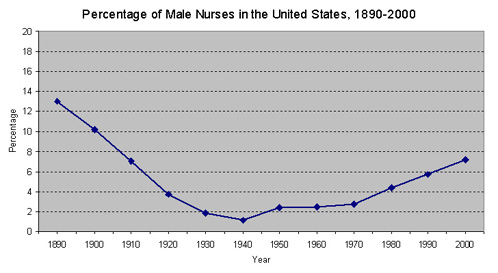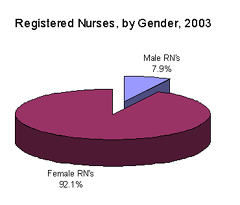By the Numbers
Men in Nursing, Occupational Therapy, and Physical Therapy
Though never predominate, male nurses have been involved in the field of nursing since its infancy. As members of religious orders, men provided some form of nursing care to the sick, wounded and dying as early as the fourth and fifth centuries. Until the mid-1800s, both male and female nurses were most likely inspired by religious or altruistic convictions and lacking in formal training.
The events that led to the professionalization of nursing also contributed to the decline of men’s association with nursing. In the mid-1800s Florence Nightingale and her followers advocated for improved education and status for nurses. Nightingale believed that every woman was a nurse, and those women who sought training as nurses were doing what came naturally to them as women. She established schools of nursing that, consistent with Victorian standards, did not mix female and male students. Men were virtually barred from nursing education.
The belief that nursing was an extension of a woman’s natural domestic role established nursing as a “woman’s” occupation of lower societal value than “man’s” occupations such as medicine. This lack of value was reflected in lower salaries. The lower salaries and status of professions labeled as “women’s work” certainly discouraged all but a few men from pursuing those fields, thus perpetuating the preponderance of women.
One of the few outlets for male nurses was asylum nursing, where their greater physical strength was required to restrain violent patients. State mental hospital schools of nursing graduated men nurses, however, the education was not as comprehensive as that in general schools of nursing. Despite a severe nursing shortage during World War II, military policy banned men from the United States Army Nurse Corps. The policy was not changed until 1955. Within a decade more than 10% of the Army Nurse Corps were men.
The percentage of men nurses in the United States dipped to its lowest point in the 1930s and 1940s; it is only now approaching 10% of all nurses. While men are no longer restricted to psychiatric nursing, there is still some gender divisions in nursing – men nurses are more common in intensive care units, emergency departments and operating rooms, and less common in pediatric and obstetric nursing.
If the continuing shortage of nurses in the United States is to be successfully addressed, increasing numbers of men will need to be recruited into the profession. Oft-cited reasons for men not entering the nursing profession are role stereotypes, gender biases, economic barriers, and lack of mentors. The lack of mentors is apparent when looking at the representation of men in nursing school faculties. According to the American Association of Colleges of Nursing, in 2001 men only comprised 3.5% of the full-time faculty and 2.4% of the deans in schools of nursing. In 2003, the percentage of male full-time faculty had only risen to 4.2%.
Nursing may indeed be the only health profession in which women dominate the numbers of professionals as well as the numbers in academic leadership roles.
The fields of occupational and physical therapy are still largely composed of women. Yet men are over-represented in academic leadership positions in these fields. U.S. Bureau of Labor Statistics data showed that about 70% of physical therapists working in the United States in 2002 were women. Only about 55% of the directors of accredited university physical therapy programs are women. U.S. Bureau of Labor Statistics data reveals that in 2003 over 87% of occupational therapists were women. In 2004 women comprised about 80% of the directors of accredited university occupational therapy programs.
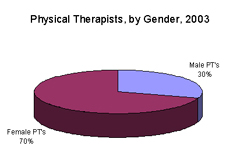 |
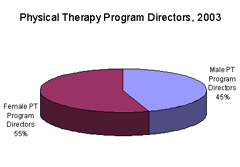 |
Source: U.S. Bureau of Labor Statistics |
Data from American Physical Therapy Association Directory of Accredited Physical Therapy Programs |
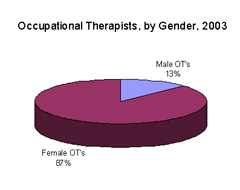 |
 |
Source: U.S. Bureau of Labor Statistics |
Data from American Occupational Therapy Association listing of Accredited Occupational Therapy Programs |
Related Links:
Return to By the Numbers
Back to Top

